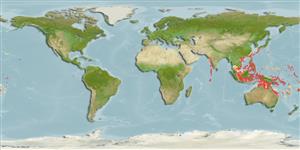Preferred temperature (Referencia
123201): 25.3 - 28.8, mean 27.7 °C (based on 214 cells).
Phylogenetic diversity index (Referencia
82804): PD
50 = 0.5000 [Uniqueness, from 0.5 = low to 2.0 = high].
Bayesian length-weight: a=0.02042 (0.01254 - 0.03324), b=2.99 (2.86 - 3.12), in cm total length, based on LWR estimates for this species & Genus-body shape (Ref.
93245).
Nivel trófico (Referencia
69278): 3.8 ±0.7 se; based on size and trophs of closest relatives
Resiliencia (Referencia
120179): Medio, población duplicada en un tiempo mínimo de 1.4-4.4 años (Preliminary K or Fecundity.).
Fishing Vulnerability (Ref.
59153): Low vulnerability (20 of 100).
🛈
Nutrients (Ref.
124155): Calcium = 47.5 [31.3, 66.3] mg/100g; Iron = 0.377 [0.239, 0.568] mg/100g; Protein = 18.5 [17.0, 19.9] %; Omega3 = 0.144 [0.101, 0.200] g/100g; Selenium = 52.4 [35.0, 76.6] μg/100g; VitaminA = 172 [32, 639] μg/100g; Zinc = 0.493 [0.392, 0.688] mg/100g (wet weight);
